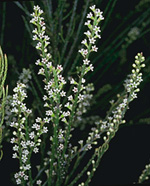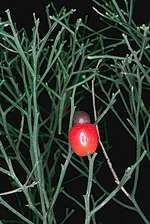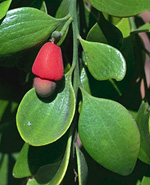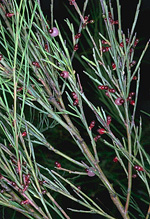 |
This family of root-parasites is widespread on all continents except in the boreal parts of the Northern Hemisphere, particularly in warm and dry regions. In Australia it is found almost throughout the mainland and in Tasmania, again more commonly in dry areas than in rainforests and other wet vegetation types.
Characteristic features of the family Santalaceae in Australia include:
- trees or shrubs, occasionally climbers or (Thesium) a short-lived
herb, often with a grey-green or distinctly yellowish-green colour
- leaves alternate or opposite, leathery and often rather thick, glabrous,
sometimes reduced to minute scales
- flowers small, greenish or cream, bisexual, without distinct sepals
and petals but instead with a whorl of usually 3–5 sometimes petal-like
perianth-lobes which are free or fused into a tube; stamens adjacent
to lobes
- ovary inferior to superior, usually with 3 carpels, unilocular, developing
into a nut or drupe which is often brightly coloured in shades of red,
yellow or pink, or with a fleshy, coloured fruit-stalk
Description
Evergreen, deciduous or semi-deciduous trees, or shrubs, or woody scrambling vines, or rarely perennial terrestrial herbs, partially or totally parasitic on the roots of the host. Perennating by rhizomes. Leaves sometimes ±absent. Stems unarmed, or rarely with thorns or spines arising from the leaf axils; internodes terete or distinctly angular. Internal secretions not obvious. Plants glabrous, or rarely with stellate, non-glandular hairs. Leaves well developed or much reduced (i.e. to scales, etc.), alternate and spiral, or opposite, or in whorls of 3, cauline if herbs, petiolate, subsessile or sessile. Stipules absent. Lamina simple, symmetric, filiform, acicular, subulate, linear, lanceolate, ovate, elliptic, oblanceolate or obovate; base cuneate or attenuate; margins entire, ±flat, involute or incurved; one-veined, or the venation pinnate, or parallel, with the midrib conspicuous or inconspicuous, and the tertiary venation not reticulate; surfaces not punctate; herbaceous, leathery or succulent. Male and female flowers occurring on the same plant or on separate plants, or with all the flowers bisexual. Inflorescences terminal or axillary, consisting of glomerules, spikes, racemes, panicles, corymbs, dichasial cymes or solitary flowers. Bracts present. Flowers odourless, sessile or stalked. Floral disc present or absent; nectaries absent or present on the disc. Free hypanthium rarely present. Perianth regular, of 1 whorl only, with 3–5 free or apparently slightly fused ±petaloid segments, valvate in bud, white, cream, yellow, orange, red, purple, green, grey, brown or black, without contrasting markings, or with streaks, spots, etc, herbaceous, succulent or membranous. Fertile stamens 3–5, opposite to and free of or partly fused to the perianth segments, free of the ovary and style, distinct from each other, all ±equal. Staminodes present or absent. Anthers dorsifixed or basifixed, versatile or not, opening inwards by longitudinal slits; 2- or 4-celled; appendages absent or dorsal. Ovary superior and sessile, or part-inferior, or inferior. Carpels (2–) 3 (–5), fused; ovary with 1 locule. Style terminal, single and unbranched, or branched above, or absent with the stigma ±sessile and lobed. Ovules 1–5, stalked or sessile; placentation free-central or apparently basal. Fruit a dry or fleshy indehiscent nut, or a drupe; the perianth on the maturing fruit deciduous, or dry and persistent. Disseminule macro-surface featureless or costate; micro-surface ±smooth, granulate or reticulate, white, yellow, red, pink, magenta, purple, violet, green, brown or black, glossy or dull. Seeds 1–5 per fruit. Aril absent or apparently present. Cotyledons 2. Embryo straight.
(Note: this description has been generated from the coded data compiled for the key. Any errors in the key data will be reflected in the descriptions.)
A treatment of the family Santalaceae has been published in:
Flora of Australia 22: 29-67.
Australian genera of Santalaceae (as recognised for the Flora of Australia)
Anthobolus
Choretrum
Dendromyza
Dendrotrophe
Exocarpos
Leptomeria
Omphacomeria
Santalum
Spirogardnera
Thesium

|
  |

Choretrum candollei (flowers)
Photo: P.Ollerenshaw © ANBG

Exocarpos cupressiformis (fruit)
Photo: M.Fagg © ANBG

Exocarpos latifolius (fruit)
Photo: M.Fagg © ANBG

Exocarpos strictus (fruits)
Photo: P.Ollerenshaw © ANBG

|
 |
|